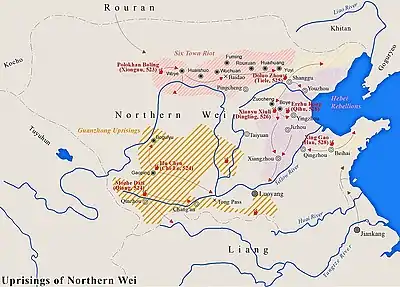Six Frontier Towns
The Six Frontier Towns (Traditional Chinese: 六鎮; Simplified Chinese: 六镇), also known as Northern Frontier Towns (北镇), refers to six military towns in the Hetao region that Northern Wei government built during Huangshi era and Yanhe era to prevent the southward invasion by Rouran. These towns were Woye, Huaishuo, Wuchuan, Fumin, Rouxuan and Huaihuang (from west to east).
The town of Woye was located in the old city of Woye of Han Dynasty, southwest of today's Linhe Country of Inner Mongolia at first, but later move to Shuofang of Han Dynasty, north of today's Hangjin Banner. The town of Huaishuo was located in southwest of today's Guyang, Inner Mongolia. Later its name was changed to Shuozhou. The town of Wuchuan was located in west of today's Wuchuan Country, Inner Mongolia.
In 528, it became a district (郡). The town of Fumin was located in southeast of today's Siziwang Banner. The town of Rouxuan was located in northwest of today's Xinghe Country. The town of Huaihuang was located in northwest of today's Chicheng Country.
The six towns
| Name | Chinese: Traditional / Simplified | Pinyin / Wade-Giles | Present day | Location |
|---|---|---|---|---|
| Woye | 沃野鎮 / 沃野镇 | wòyě zhèn / wo-yeh chen | Woye City ruins, Northeast of Linhe District, Bayan Nur, Inner Mongolia | 41.1400°N 108.7947°E |
| Huaishuo | 懷朔鎮 / 怀朔镇 | huáishuò zhèn / huai-shuo chen | Bailingnao City ruins, Bailingnao, Northeast of Guyang County, Baotou, Inner Mongolia | 41.2097°N 110.1336°E |
| Wuchuan | 武川鎮 / 武川镇 | wǔchuān zhèn / wu-ch'uan chen | Erfenzi City ruins, Erfenzi Township, West of Wuchuan County, Hohhot, Inner Mongolia | 41.3611°N 110.6996°E |
| Fuming | 撫冥鎮 / 抚冥镇 | fǔmíng zhèn / fu-ming chen | Tuchengzi City ruins, Southeast of Siziwang Banner, Inner Mongolia | 41.4628°N 111.7433°E |
| Rouxuan | 柔玄鎮 / 柔玄镇 | róuxuán zhèn / jou-hsüan chen | Halagou City ruins, Taijimiao, Northwest of Xinghe County, Ulanqab, Inner Mongolia | 41.2573°N 113.9616°E |
| Huaihuang | 懷荒鎮 / 怀荒镇 | huáihuāng zhèn / huai-huang chen | Baiyin Tsagan City ruins, Zhangbei County, Zhangjiakou, Hebei |

Six towns rebellion
The population of the six towns region consisted mostly of Xianbei nobles and soldiers who guarded the northern border against the Rouran. Emperor Xiaowen's sinicization campaign had ostracized these traditional Xianbei warrior families, making them felt disrespected and unprivileged compared to Xianbei nobles in Luoyang. In 523, nomadic Rouran tribes suffered a major famine due to successive years of drought. In April, the Rouran Khan sent troops to plunder Huaihuang to solve the famine. People of the town rose up and killed the town's commander.
Rebellion soon broke out against the Luoyang court across the region. In Woye, Poliuhan Baling (破六韓拔陵) became a rebel leader. His army quickly took Woye and laid siege to Wuchuan and Huaishuo.
Elsewhere in Qinzhou (morden Gansu province), Qiang ethnic leaders such as Mozhe Dati (莫折大提) also rose up against the government. In Gaoping (present-day Guyuan), Hu Chen (胡琛) and the Xiongnu rebelled and titled himself the King of Gaoping.
The Poliuhan Baling rebellion was defeated in 525. However, other anti-Sinicization rebellions has spread to other regions such as Hebei and Guanzhong and only be pacified as late as 530 by Erzhu clan (尔朱氏).